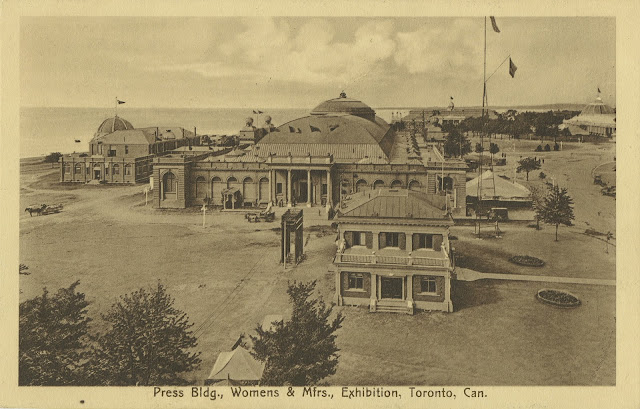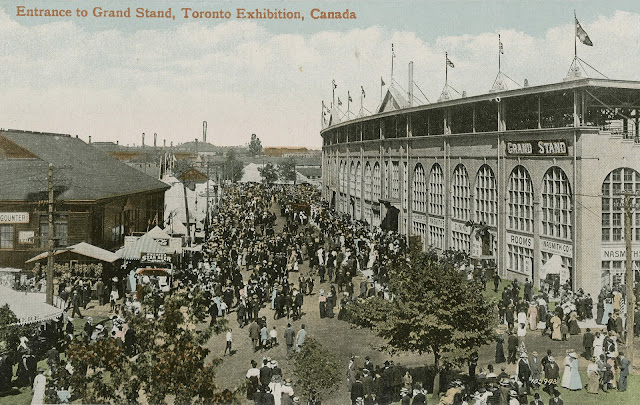IMPORTANCE: No
performing arts facility in Toronto’s history quite equals that of the
Grand Opera House. It is recalled in the name of the lane way existing
today.
Built: 1874
 Demolished:
Demolished: 1927
What exists there now: Scotia Plaza
Why it's missed: A fabulous Second Empire-style
building with an an intriguing history courtesy of one-time owner
Ambrose Small, the millionaire that one day up and vanished, nothing
like it remains in Toronto.
The Grand Opera House was an opera house and concert hall located in Toronto, Ontario, Canada.
Opened in 1874 on Adelaide Street West, west of Yonge Street, the Grand Opera House was Toronto's premier concert hall during the late 19th century. Designed in the Second Empire style with 1750 seats, the hall was the first in the city to feature gaslights that could all be switched on or off simultaneously with one electric switch.
The Grand Opera House's stage hosted some of the era's best-known performers, including actors Maurice Barrymore, Sarah Bernhardt and Sir Henry Irving, soprano Emma Albani, as well as Italian baritones Giuseppe Del Puente and Antonio Galassi. Visiting lecturers included Oscar Wilde. During its initial years, the Grand Opera House was managed by Charlotte Morrison, a former actress, and the guiding force at that time behind Toronto's opera and theatre scenes. Morrison has been described as the "Ed Mirvish of her time".
The Grand Opera House suffered a number of fires, including a major blaze in 1879 that killed a stage-carpenter, as well as his wife and infant daughter. Although the hall was restored and reopened after each fire, it slowly fell into neglect with the arrival of the vaudeville age in the 1900s, which brought with it newer and more modern vaudeville theatres to Toronto, most notably the Loews and Winter Garden Theatres on Yonge Street.
In 1919, the Grand Opera House became embroiled in an infamous and widely reported criminal investigation. On December 2, the Grand Opera House's owner at the time, Ambrose Small, deposited a cheque for a million dollars in a nearby bank, and went missing later that day.
Before his disappearance, Small already had a reputation in Edwardian era Toronto as a gambler, and booked less reputable, more titillating shows to his string of theatres, including the Grand Opera House. The newspapers published every known detail of the police investigation into his disappearance, and soon it was revealed that Small had kept a secret sex room at the Grand Opera House, where he entertained numerous mistresses.
The concert hall never recovered from the fires, the neglect and the scandal, and it was demolished in 1927. The site of the former Grand Opera House is now occupied by the 68-storey Scotia Plaza in Toronto's Financial District. The sole remaining physical legacy of the concert hall is a small lane running south from Adelaide Street West, named "Grand Opera Lane".
Disappearance of Ambrose Small
Ambrose Small
|
|---|
 |
|
|
|---|
|
|
|---|
|
|
|---|
Grand Opera House, 11 Adelaide Street West, 1913. City of Toronto Archives, Fonds 200, Series 372, Subseries 41, Item 516.
For several generations, until at least the 1960s, a running joke for
Torontonians was that the foundation excavations for each new building
might finally uncover the long-lost remains of Ambrose J. Small.
A millionaire who made his fortune in the theatre business based out of
the Grand Opera House on Adelaide Street, Small’s baffling
disappearance in late 1919 became one of the country’s most legendary
unsolved mysteries. In life, Small seemed an unimpressive public figure,
but investigations revealed unsavoury elements in his character that
fuelled salacious nationwide newspaper headlines that made him, after
his disappearance, larger than life.
Image from the Toronto Star, January 3, 1920.
|
|
|---|
|
|
|---|
| Ambrose J. Small was born in Bradford, Ontario, in 1867 |
|
|---|
|
|
|---|
His father was a proprietor at the Grand Hotel on Toronto’s Adelaide
Street West. Seeking to instil in his son a tireless work ethic, the
elder Small convinced the owner of the Grand Opera House, located across
the laneway from the hotel, to give his son a job in about 1884.
Demonstrating business acumen, Ambrose Small rose quickly from assistant
treasurer to treasurer.
By 1889, he had fallen out with the Grand Opera House’s manager, Oliver
Barton Sheppard, and moved down the street to manage the Toronto Opera
House. As manager and part-owner, he gained insight into how the
international touring and booking syndicates that brought plays and
vaudeville acts to theatres across North America worked. And so when
Small purchased a number of theatres in cities across Ontario, beginning
with Toronto’s Grand Opera House, these formed the nucleus of a
thirty-four-theatre circuit in which he—not New York
syndicates—controlled the bookings and touring shows.
Astutely sensing the sorts of shows that would appeal to the public,
Small specialized in staging scintillating plays that imagined the
sexual lives of single women. At the time of his disappearance, the
Grand was showing
Revelations of a Wife, a tawdry melodrama. His other productions explored similarly racy themes with titles like
Bertha the Sewing-Machine Girl or
School for Scandal. Such near-burlesque entertainments raised eyebrows among puritan Toronto’s elite, but they also certainly filled seats.
Ambrose married Theresa Kormann on November 6, 1904, in York (Toronto). To the public eye, the couple were upright citizens, among the elite of
Toronto society. He was a member of exclusive organizations like the
Empire Club, Canadian Club, and the Yacht Club. Likewise, she was a
member of the Women’s Canadian Club, the Toronto Ladies’ Club, the
Musical Club of Toronto, the Women’s Art Association of Toronto, as well
as an officer in the I.O.D.E. She, a Catholic, was a philanthropist who
gave regularly to Catholic charities, such as the St. Vincent de Paul
children’s orphanage. Her husband, a Protestant, sometimes accompanied
her to make presentations, even though he had at least once grumblingly
professed that he had no use for either Catholics or children.
Disappearance
Seeing declining returns on touring shows but increased costs of
productions, the Smalls grew restless with the theatre business after
the First World War. On a brief business trip to Montreal in the fall of
1919, Small negotiated a deal to sell his chain of theatres to the
Trans-Canada Theatres Limited for $1.7 million. On December 2, 1919, the
purchasers visited to Toronto to finalize the deal. In a meeting, Small
accepted a million-dollar cheque (with the balance to be paid in
instalments over the years). The transaction concluded, Small sent his
wife to deposit the cheque at the Dominion Bank’s main branch at King
and Yonge while he ran errands—buying her a Cadillac, a fur, and
jewellery. They lunched together before Small returned to his office at
the Grand Opera House to share a celebratory cigar with his lawyer, E.F.
Flock. Flock stepped out into a snowstorm at about 5:30 p.m. to catch
an evening train, but Small was never seen again (a newsboy’s claim that
Small had bought a paper from him was later refuted as mere hunger for
publicity).
Small had no motive to disappear: the millionaire did not take money with him, nor was there any ransom
note, let alone evidence of kidnapping. At 53, Small owned theatres in
seven Ontario cities and was the controller of 62 other buildings, a
self-made millionaire at the height of his career. Because Ambrose Small
was known to disappear occasionally to womanize and carouse, his
absence was not reported nor was it noted for several weeks. In January
1920, Small's attorney, F. W. M. Flock, along with Teresa Small, now
alarmed by Small's lengthy absence, notified the local police. Teresa
Small offered a $50,000 reward for information about her husband's
disappearance and whereabouts. The reward went unclaimed.
Links
https://static.torontopubliclibrary.ca/da/pdfs/grandoperahouse00granuoft.pdf
https://tayloronhistory.com/
https://tayloronhistory.com/2016/03/14/grand-opera-house-on-adelaide-street-toronto/

 Osgoode Hall Library with ornate ceiling and fireplace
Osgoode Hall Library with ornate ceiling and fireplace Osgoode Hall Library with ornate ceiling and fireplace
Osgoode Hall Library with ornate ceiling and fireplace
























































